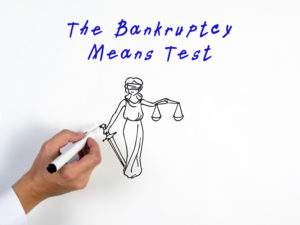Contents

The Means Test is a formula designed to determine whether the total household income of a person filing for bankruptcy is above or below a certain amount.
Part 5 of our series of Articles on how to read and review the bankruptcy petition prepared for you by your Michigan bankruptcy attorney will discuss in detail the all-important Chapter 7 and Chapter 13 Bankruptcy Means Test.
In Parts 1, 2, and 3 of this Article, we described the points you should focus upon when reviewing the main substance of your draft documents: the Voluntary Petition for Bankruptcy itself, Certificate of Credit Counseling, Summary of Assets and Liabilities, the Petition Schedules, and the Statement of Financial Affairs. In Part 4, we described the items important to review in the documents between the Statement of Financial Affairs and the Means Test.
The Means Test is important—and confusing enough—to merit a review guide of its own.
Let’s get started.
The Means Test
The dreaded Means Test caps off the petition for those of you filing for Chapter 7 bankruptcy. It is the last component to review before the Chapter 13 Plan for those of you filing for Chapter 13.
Note that, again, a full discussion of the purpose of the Means Test and how the Means Test calculates your income to determine whether or not you or eligible for Chapter 7 or Chapter 13 bankruptcy is located elsewhere on our website.
Here, the point of the discussion is to draw your attention to the points of the Means Test that you need to check carefully for accuracy before signing and filing your bankruptcy petition.
That said, let’s continue.
First, note that the Chapter 7 and the Chapter 13 versions of the Means Test are slightly different from one another.
-
The Chapter 7 Statement of Your Current Monthly Income
If you are filing for Chapter 7, this document either comprises your entire Means Test or is the first of two documents comprising your fully calculated Means Test.
That is, the Chapter 7 Means Test may include two documents, or forms, for some people. For others, just this first one will be included in your review package.
The difference will lie in your household income.
The Chapter 7 Statement of Your Current Monthly Income (or “CMI”) calculates your household income before deductions based on the 6-month period of time prior to the month in which you are filing the bankruptcy case.
Much of the Means Test is some level of legalese, best understood by experienced bankruptcy attorneys.
The first place that you will want to look, as a non-lawyer, is the small box at the top right of the first page. This is the box containing 3 check-boxes. These check-boxes feature 3 alternative results for this form:
- There is no presumption of abuse
- The calculation to determine if a presumption of abuse applies will be made under Chapter 7 Means Test Calculation
- The Means Test does not apply now because of qualified military service but it could apply later.
If you are active-duty military, discuss that last option with your lawyer if it is not checked. (Note: It does not apply just because you’re in the military right now.)
Otherwise, if you “pass” the Means Test cleanly, based on your gross income alone, the first “no presumption of abuse” box will be checked. This form will all that there is to your Means Test.
If your gross (pre-deduction) income does not pass you under the median income for a household of your size, the second box will be checked. The “Chapter 7 Means Test Calculation” form is “Part 2” of the Means Test, and its mathematical result will determine whether you pass or not.
So, glancing at this box, you may note your end or intermediary Means Test result.
If your attorney has attached a sheet at the end of the entire Means Test itemizing the gross income amounts input into the Means Test on a month-by-month basis, this will be the next most helpful thing to check for accuracy.
If you see that, for example, your gross income input for a month is exceedingly high, you may want to check with your lawyer and re-examine the paystubs or other income documentation you provided to him or her. Did you accidentally provide 2 copies of the same paystub?
Likewise, if a month’s income amount is too low or if you now remember that you failed to inform your attorney of the annual bonus you received 2 months earlier—now is the time to bring that up.
Under-reporting income or mis-reporting income on your Means Test can lead to a denial of your discharge or dismissal of your case.
Otherwise, from that review, you may proceed through the rest of this 3-page (or so) form.
It simply takes that gross income data that was input and calculates your “CMI” (current monthly income).
That number can be found on Line 11 of the form. Below that, the form multiplies the number by 12 (months) to arrive at gross average household income and compares that amount to the median income for a household of your size.
If you’re below that number, you’re done with the Means Test.
If not, proceed to …
-
The Chapter 7 Means Test Calculation
This Means Test form is designed to allow you to deduct certain necessary expenses from your gross income.
If the first form did not determine that you’ve passed the Means Test “cleanly,” by virtue of your gross income alone, this is your second bite at the apple.
Most of this form will be less than clear to you, as a non-lawyer. However, again, at the top of page 1 is a handy box that tells you that you either have passed the Means Test (no presumption of abuse) or have not (there is a presumption of abuse.)
Beyond that box, what is important to remember about Means Test deductions, before you review this form, is that some of the allowed deductions are “statutory” while others mirror your actual out-of-pocket monthly average expenses.
Your bankruptcy lawyer knows which are which. Ask questions if you see anything here that puzzles you.
However, to provide a couple of examples, the “Housing and Utilities” deduction on Line 8 is simply based on the IRS allowable household deduction for a household of your size (in your area). If you spend $9,000 per month more than that because you only burn whale blubber for heat—discuss with your attorney.
On the other hand, the Childcare expense on Line 21 should be the same as what you entered for that expense on your Schedule J. That is, it should be your actual monthly expenditure.
Scan through, ensure accuracy. Don’t be afraid to ask questions to your lawyer if you don’t understand one number or another.
The final calculation determining whether or not you present a presumption of abuse (Means Test failure) or not begins in Part 3 of the form, on Line 39. On Line 42, you will find the end result calculation.
Note that Part 4 of this form allows for the addition of “Special Circumstances” deductions. These deductions are actually legal arguments, not objects of straightforward math.
If you have given good information and documentation to your lawyer, he or she will include or will not include anything there, depending.
-
The Chapter 13 Means Test
If you do “fail” the Means Test, you are required to file Chapter 13 rather than Chapter 7 bankruptcy.
You may be, in fact, filing Chapter 13 on purpose, regardless of your income, because you need to save your home from foreclosure or to take advantage of one of the other benefits of the Chapter 13 process not available in Chapter 7.
You will still need to file a Means Test.
The Chapter 13 version is a little different than the Chapter 7 version.
This form is titled, “Chapter 13 Statement of Your Current Monthly Income and Calculation of Commitment Period.”
That long-winded title captures the differing intent of this Means Test version: to snapshot your income for the purpose of determining whether you are required to be in a 3-year Chapter 13 process (“passed the Means Test”) or must complete a 5-year Chapter 13 process (“failed the Means Test”).
The now-familiar little box at the top of the first page tells you what your result is.
This result is based on the same sort of calculation as described above, regarding the Chapter 7 version of the Means Test.
Again, scan through, review the gross income input, all deductions, and ask questions of your lawyer as needed.
The “applicable commitment period” (3 vs. 5 years) is calculated in Part 3, beginning on Line 18.
“Part 2” of the Chapter 13 Means Test reaches another purpose: to determine whether or not you have “disposable income.”
This means you have or do not have money left over at the end of the hypothetical earning month calculated by the Means Test, after necessary expenses and deductions.
If you do have “disposable income,” you may be required to pay some minimum amount of money to your unsecured creditors in your Chapter 13 Plan.
For example, if you have $100 of disposable monthly income (or “DMI”) and you are filing a 5-year (60 month) Chapter 13 Plan, you will be required to pay $6,000 in total to your unsecured creditors (as a pooled group) through your Plan. That’s $100 x 60.
The little box at the top of the first page of the first Chapter 13 Means Test form tells you if you have DMI or not.
Part 2 of this Means Test is titled “Chapter 13 Calculation of Your Disposable Income,” and this is where deductions are applied to reduce this DMI number.
Review all deductions, remembering that some are statutory and not personal to you or your household. The final DMI amount is located on Line 45 of this form.
Finally, whichever version you are filing—make sure you’ve signed both forms where indicated.
How to Read and Review the Bankruptcy Means Test: The Bottom Line
The bottom line is that the Means Test is best prepared and explained by an experienced bankruptcy attorney. However, it will still be filed with your signature on it and no one else’s. It behooves you to scrutinize each and every line item on the forms—and ask questions and suggest corrections as appropriate.
Attorney Walter Metzen is a Board-Certified Bankruptcy Expert who has successfully assisted thousands of Metro Detroit Chapter 7 and Chapter 13 bankruptcy clients.
If you are seeking assistance with your bankruptcy filing, contact us now to schedule your free initial consultation.




